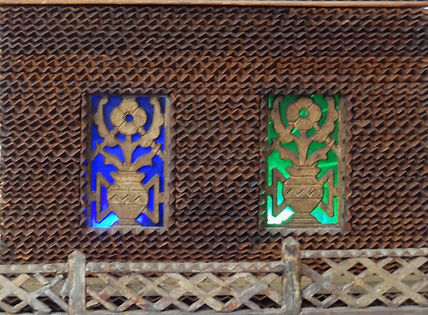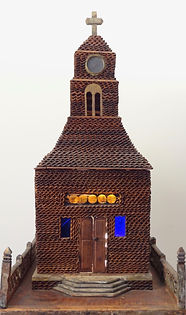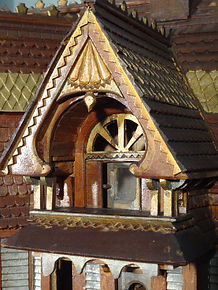

American Folk Art Buildings
architectural imagination and storied places rendered small
TYPES
Chip Art
Wood worked with skill and imagination yields a look and a building technique
Chip art -- work and look and style -- shows carved wood, shaped or patterned or faceted, often in layered strips. Carving with some intricacy into the surface of wood is also seen. Imaginative variations and expressions are possible. Details can be expressed. The required carving technique, when well rendered, demands care and presumably patience, surely intensive of both labor and time.
The look and resulting works are broadly also called tramp art, which has the advantage of established familiar usage and the disadvantage of misleading inaccuracy about makers and intent. Mostly made from the late 19th century until the mid 20th century, the cultural or national antecedents are unclear although German craft and immigrants seem a strong source. Domestic and functional objects were made in endless numbers around the country -– frames and boxes, decorative objects, stands and containers, almost any item found about the house and makeable from wood. Some are schlocky and some masterful. The things were pervasive and relished for function as well as artful pleasure.
Buildings are rare and often yield chip art work as applied trim or detail or fancy rather than the overall technique. Perhaps a guy adept in the technique decided for some reason to apply his skill to a church or other building rather than a mirror frame. The look works particularly well for Victorian evocation and for roof covering rows and can yield a (German) Gothic-y look. Unsurprisingly, given the distinctive strength of the work, chip artful buildings are not much realistic in look or intent.
In the hands of an imaginative and skilled renderer, chip art can yield buildings -- particularly churches -- of vision, beauty, and expressive American material culture.

































59" high
60" high











































Look at this impressive place, surely the best in town or around, so likely the strong showy arrival notice of the local mill or bank owner. The architecture reads clearly and realistically: a richly assertive, Queen Anne here and Victorian there, towered, porte-cochered large house of the last third of the 19th century. Balusters and basement windows, doodads and trim, and everything in fact are carefully created, right in scale and building detail, suggesting that an actual building is conveyed.
However, making the architectural clarity all the more striking, the rendering is so very not realistic. Every bit and curve and surface shows layered horizontal chip arty patterns. Endless skill and unafraid imagination combine to craft architectural and visual affect everywhere on everything.
As always, grand architectural aspiration impels challenges and problem solving. Here, chip artful technique evolves into manifest unbridled passion technique. The interior reveals the meticulous and surely laborious construction. Each exterior row of varying pattern is a single crafted length, long or short, straight or curved or shaped, stacked and joined and hard to imagine from the outside.
Who could have imagined it all working so well?






Figure-ground resolution reveals
MB
embedded as elusively as deliberately.